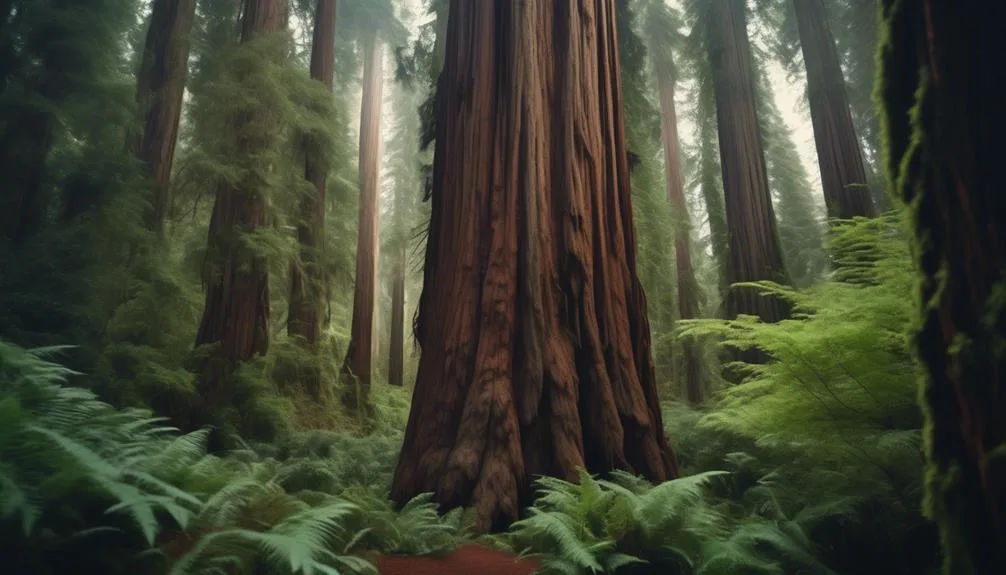Ever wondered why some redwood trees live for over 2,000 years?
Picture standing in a forest of ancient giants, their huge trunks reaching for the sky.
The secret to their long life lies in their unique biological traits and their ability to thrive in specific environments.
But that's not all.
The slow growth, disease resistance, and conservation of old-growth habitats also contribute to these trees' remarkable lifespan.
Unique Biological Adaptations
Redwood trees have developed unique biological adaptations that allow them to thrive in their specific environment, making them truly remarkable specimens in the natural world. One of the key factors contributing to their longevity is their efficient resource allocation.
Redwoods have evolved to efficiently distribute resources to different parts of the tree, ensuring their survival in harsh conditions. This efficient resource allocation enables them to withstand environmental stress and continue to grow for thousands of years.
Moreover, redwoods boast exceptional genetic diversity, which is crucial for their long-term survival. This diversity allows them to adapt to changing environmental conditions, resist diseases, and thrive across varied habitats. Their genetic adaptability provides a robust foundation for the species, ensuring their continued existence for generations to come.
Environmental Factors
Efficient resource allocation and genetic diversity have allowed redwood trees to thrive.
Now, let's explore the environmental factors that further contribute to their remarkable longevity.
Climate influences play a crucial role in the redwood's prolonged lifespan. The cool, foggy coastal climate of their natural habitat provides moisture and moderate temperatures, which are conducive to their growth and survival.
Redwoods also benefit from the unique soil composition found in their environment. The well-drained, acidic soils rich in nutrients, such as nitrogen and phosphorus, support their towering presence.
These factors contribute to the trees' ability to resist disease and withstand environmental stressors, ultimately promoting their long lifespans.
Understanding the intricate relationship between redwoods and their environment sheds light on the remarkable adaptability and resilience of these iconic giants.
Slow Growth and Regeneration
In the slow, deliberate pace of growth and regeneration, redwood trees demonstrate a remarkable resilience and adaptability to their environment. These majestic trees have evolved strategies to thrive for centuries, despite their slow growth. Redwoods are able to endure for so long due to their ability to regenerate and their resistance to environmental stressors.
- Nutrient rich soil: Redwoods thrive in nutrient-rich soil, which allows them to slowly and steadily grow over time, making the most of the available resources.
- Fire resistance: Redwood trees have developed a remarkable resistance to fire, allowing them to survive and even thrive in fire-prone regions. Their thick bark and high water content help protect them from wildfires, promoting their longevity.
The slow growth and regeneration of redwood trees are key factors in their astonishing ability to live for thousands of years.
Disease and Pest Resistance
With their resilience against environmental stressors, redwood trees also display impressive resistance to diseases and pests, contributing to their remarkable longevity and vitality. Redwoods have developed a natural defense system against various pathogens and pests, making them highly resistant to common tree diseases and insect infestations.
One key factor in their disease resistance is the presence of chemical compounds like tannins and phenolics, which inhibit the growth of harmful microorganisms. These compounds not only protect the tree from diseases but also deter pests due to their bitter taste and toxicity.
Additionally, the thick, fire-resistant bark of redwoods acts as a physical barrier, preventing pathogens and pests from penetrating the tree's vital tissues. This robust defense mechanism plays a critical role in the redwood's ability to thrive for thousands of years in challenging ecosystems.
Conservation of Old-Growth Habitats
Amidst the awe-inspiring grandeur of ancient redwood forests, the conservation of old-growth habitats stands as a paramount endeavor crucial to preserving the ecological richness and biodiversity of these magnificent ecosystems. Protecting these habitats is vital for maintaining ecosystem balance and sustaining species diversity.
- Ecosystem Balance: Old-growth forests play a crucial role in maintaining the delicate balance of ecosystems. Their complex structure and diverse plant and animal life contribute to the regulation of nutrient cycles, water flow, and climate patterns.
- Species Diversity: These habitats are home to countless species, many of which are unique to old-growth forests. Preserving these areas is essential for safeguarding the rich tapestry of life they support.
- Conservation Efforts: Initiatives focused on preserving old-growth habitats aim to protect these invaluable ecosystems, ensuring their continued existence for future generations.
Conclusion
In awe of the redwood trees' longevity, we witness nature's remarkable resilience and adaptability.
Their slow growth, disease resistance, and conservation of old-growth habitats all contribute to their enduring presence.
As we marvel at these magnificent giants, let's ponder the lessons they hold for our understanding of the natural world and the potential for longevity in our own lives.
Mark Hoffman is a dedicated arborist and tree care specialist with over a decade of experience. His love for trees began when he visited Yosemite National Park as a teenager and was awestruck by the giant sequoias. Mark pursued his passion by studying forestry at Michigan Technological University, where he earned a Bachelor of Science degree.
Since then, he has worked tirelessly in the field of arboriculture, helping to preserve and protect trees in his community. His expertise and dedication have made him a respected leader in the industry and a valuable resource for anyone seeking advice on tree care.
